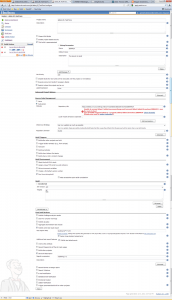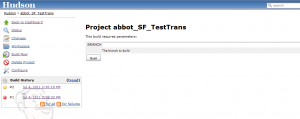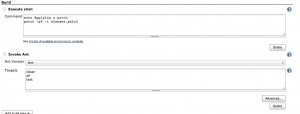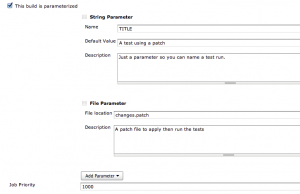Off-loading your test execution using Hudson
One of the annoyances if you have a load of tests for a particular project is that running them can tie up your machine for a while. There are also sometimes consistency issues when running on different machines with different window managers and operating system versions. One thing we do is for every main hudson job we create a copy just to run the tests for a particular developer. It solves the ‘it runs on my machine’ dilemma and frees up the developer to get on with other work. In our part of the organization running the tests on another machine is a mandatory step before merging to main.
This example uses subversion; but it most likely work equally well with any other source control system with a similar interface. It also assumes that all the developers are working on branches, you are doing this right?.
First of all you take a copy of you original job, in my case I am running test for the abbot project so I am starting with ‘abbot_SF’, and create a copy of this job with a suitable postfix. In our case the job is called ‘abbot_SF_TestTrans’. You need to first disable any normal build triggers so this job only gets used when there is a manual action. We keep the results separate as it makes the normal build results much easier to interpret.
So to this new job add a new Parameter ‘BRANCH’ of type string and update the repository URL to contain this parameter, so in my case https://abbot.svn.sourceforge.net/svnroot/abbot/abbot/branches/$BRANCH. You will also notice that I have the used the description setting plugin to capture the branch name automatically. (You could also just put the $BRANCH parameter in the description field and leave the RegEx blank). After you have finished you have something like this, ignore the red ink as that appears to be a local configuration issue.
Now if you click build on the job you get a nice interface where you can ask Hudson to build a particular branch, leaving the developer to get on with the next job while the build machine does it’s business.
Speaking of that, it looks like I have some bugs to fix…
You might also want to tick the ‘Execute Concurrent Builds if necessary’ flag so that if you have more than one developer you can make proper use of your farm.
It turns out this can be quite simple, you just need to make use of a job parameter that takes a File as it’s input, this is then written to the specified location in the workspace. In my example I have the following two parameters, the Title allow me to name the job and this property is picked up later by the job Description plugin.
Once you know where the patch is located you can just apply the patch before you perform the required build steps, here is an example using SVN so we use the unix patch command, git users can use the git command instead for this.
And there you are, you can test a user submitted patch for testing without tying up your development machine. You can also run the tests more than once to check for any intermittent tests which can be very valuable in concurrent environments.
I forgot to mention a very important plugin that is essential if you want to convince your developer to preflight there work. The problem is that is the slave allotment/smallholder/farm is busy running other jobs then they are forced to wait before merging.
The easy solution to this problem is the priority sorter plugin. This allows you to specify that some jobs are more or less important then others. The default priority is 100, so seeing your preflight job to 1000 should see it jump to the front of the queue.
It is interesting how the length of tests affects my commuting behaviour, now that is take around an hour to run the long tests just for our components. It makes sense to start a work at home, kick of a job and you should have you nice shiny test results by the time we get into work. One day I might even get a blue ball if I am so very lucky with our dependencies. :-)
Reference: Off-loading your test execution using Hudson, Off-loading test execution using Hudson part 2, Off-loading test execution using Hudson part 3, skipping the queue from our JCG partner Gerard Davison at the Gerard Davison’s blog blog.










Jenkins > Hudson